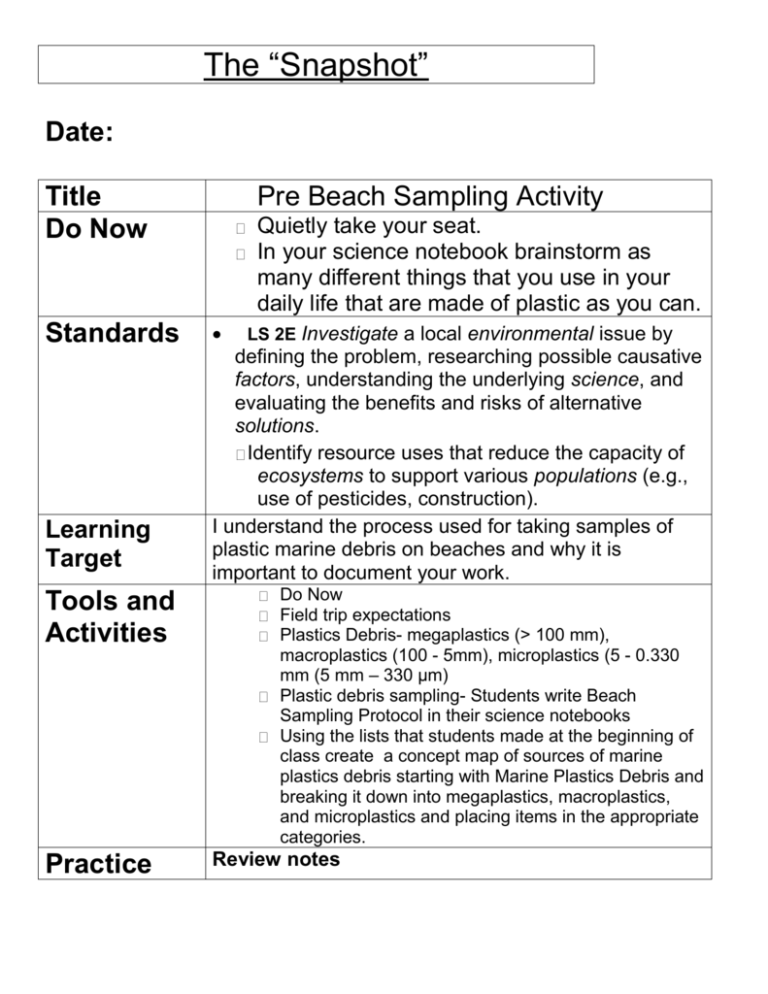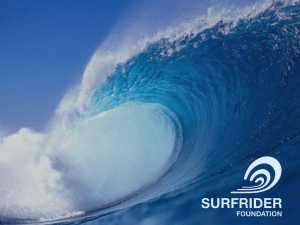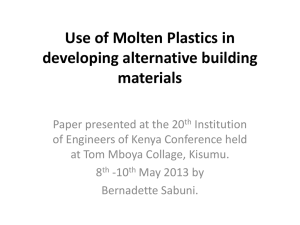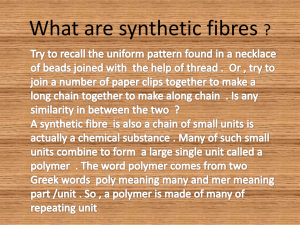Marine Debris Sampling Protocol and Lesson Plan
advertisement

The “Snapshot” Date: Pre Beach Sampling Activity Title Do Now Standards Learning Target Tools and Activities Practice Quietly take your seat. In your science notebook brainstorm as many different things that you use in your daily life that are made of plastic as you can. LS 2E Investigate a local environmental issue by defining the problem, researching possible causative factors, understanding the underlying science, and evaluating the benefits and risks of alternative solutions. Identify resource uses that reduce the capacity of ecosystems to support various populations (e.g., use of pesticides, construction). I understand the process used for taking samples of plastic marine debris on beaches and why it is important to document your work. Do Now Field trip expectations Plastics Debris- megaplastics (> 100 mm), macroplastics (100 - 5mm), microplastics (5 - 0.330 mm (5 mm – 330 µm) Plastic debris sampling- Students write Beach Sampling Protocol in their science notebooks Using the lists that students made at the beginning of class create a concept map of sources of marine plastics debris starting with Marine Plastics Debris and breaking it down into megaplastics, macroplastics, and microplastics and placing items in the appropriate categories. Review notes Beach Sampling Protocol (modified from http://www.ptmsc.org/beachplastic_survey.html) Objective: To determine amount of beach plastic accumulating on beaches. Materials: Quadrate (2) gps (2) Clipboard (2) Forms (8) Pencils (2) Garden shovels (2) 5 mm sieve (2) 1 mm sieve (2) Plastic trays (8) Quarter zip lock bags Sharpies (2) Foreceps (4) (24) Gallon zip lock bags Plastic culture plates (4) Gloves (M & L) (4) Location of sample: highest wrack line on beach. Sample locations will be 10 paces apart, parallel to the waterline. Step 1: set-up quadrate, sketch area, record latitude & longitude, note date & time. Pick out large pieces of debris and place in megaplastics (>100 mm) sample bag labeled with location lat, long, date, time. Remove other large debris. Step 2: evenly scrape substrate in each quadrate and place in smaller bucket. Step 3: place fry basket (~5mm) into 5 gallon bucket. Pour and sieve material from the smaller bucket into 5 gallon bucket. Place into macroplastics (5-100 mm) sample bag labeled with location lat, long, date, time. These will be sorted back at school. Step 4: place food sieve (~1-5mm) into second 5 gallon bucket. Poor and sieve material from the smaller bucket into 5 gallon bucket. Pour contents into microplastics (.330-5 mm) sample bag labeled with location lat, long, date, time. These will be picked back at school. Step 5: fill gallon bag with sieved contents. Step 6: sort plastic samples from macroplastics and microplastics bags. Pour contents of each bag onto a tray. With forceps, pick out plastic pieces. Note category and number in log. Note debris type on form for megaplastics. Beach Sampling Log Date: _________________________________ Time: ________________________________ Location: _____________________________________________________________________ Latitude: _____________________________ Longitude: _____________________________ Sampling Group: _______________________________________________________________ ______________________________________________________________________________ Sketch of Location: Post Field Trip Activity Place debris on sorting trays and have students use forceps to remove plastics from debris. Sort debris by fragment type, entering number and category information in data chart. Megaplastics Category Fragments: hard plastic Foams: polystyrene, insulation, etc. Pellets: preproduction plastic pellets Films: bags/wrappers Filament: fishing line, rope, synthetic cloth Cigarette parts: butts, filters Glass: glass fragments, shards Other: rubber, metal, etc. Number Comments Macroplastics Category Number Comments Number Comments Fragments: hard plastic Foams: polystyrene, insulation, etc. Pellets: preproduction plastic pellets Films: bags/wrappers Filament: fishing line, rope, synthetic cloth Cigarette parts: butts, filters Glass: glass fragments, shards Other: rubber, metal, etc. Microplastics Category Fragments: hard plastic Foams: polystyrene, insulation, etc. Pellets: preproduction plastic pellets Films: bags/wrappers Filament: fishing line, rope, synthetic cloth Cigarette parts: butts, filters Glass: glass fragments, shards Other: rubber, metal, etc. Answer the following questions in your science notebook: 1. What is the mass of plastics the sample you collected? Determine the concentration of plastics in the sample. To do so, divide the mass of plastics by the volume of material sampled. This will give you the concentration of plastics in g/L. 2. Speculate as to the sources of your plastics collected. 3. Extension Activity using the Applications process: Have students design solutions to the following problem. This assignment was designed using the OSPI template. 0 Students are working to design solutions to the problem of increasing plastics in the ocean environment. Describe how to begin solving this problem. Be sure to describe these stages in your design process: Research the Problem: Describe any scientific information needed to solve the problem and how to collect that information. Explore Ideas: Describe several possible solutions to the problem, including any useful scientific concepts. Problem: The amount of plastics in the ocean environment is steadily increasing with time. What ways can we sustainably reduce the amount of plastics present in the ocean environment? Research the Problem: Explore Ideas: 0 Students need to choose one of their ideas for reducing the increase of plastics in our oceans, and explain why they chose the idea. Describe how to design and test a way of solving the problem of increasing plastics in our oceans. Be sure to describe these stages in your design process: Plan Summary: Write a summary of the plan, including a scientific reason for choosing this solution. Test Solution: Describe the process to measure or observe how well this solution may solve the problem. Problem: What ways can we sustainably reduce the amount of plastics present in the ocean environment? Plan Summary: Test Solution: Students work can be presented as a PowerPoint, poster, educational video to teach others about solutions to the plastics problem!






